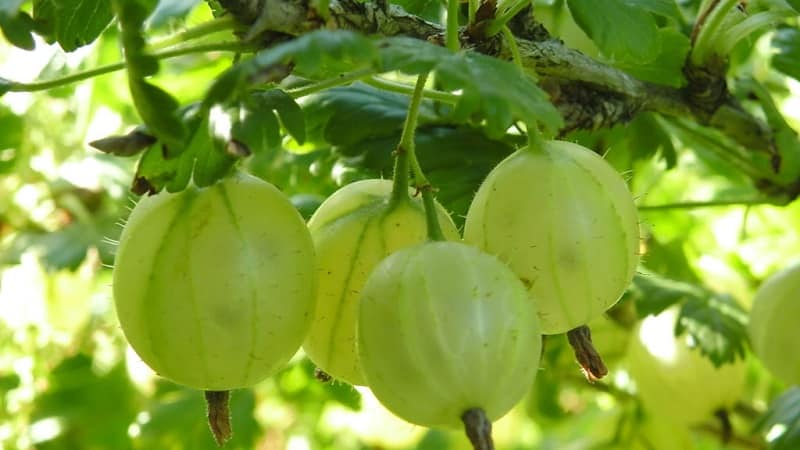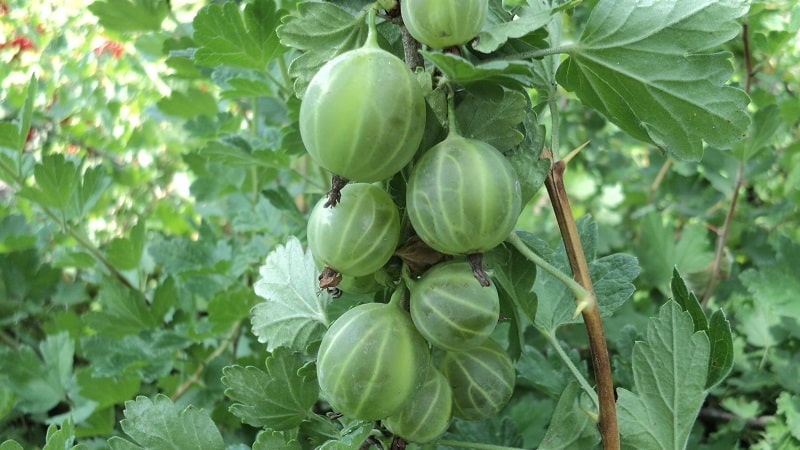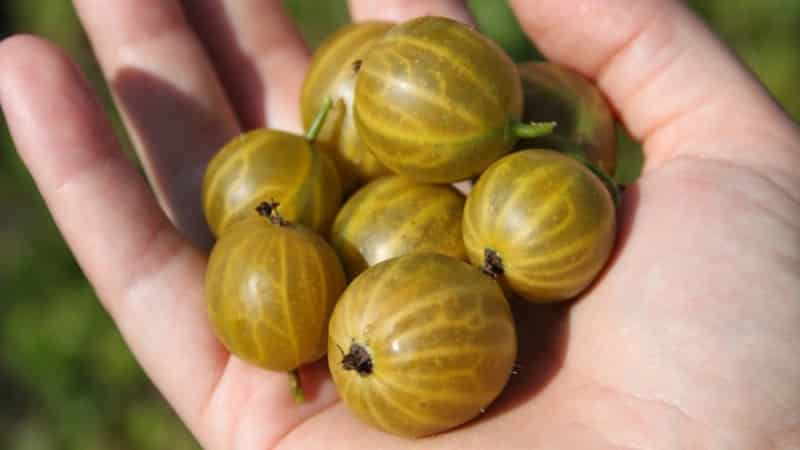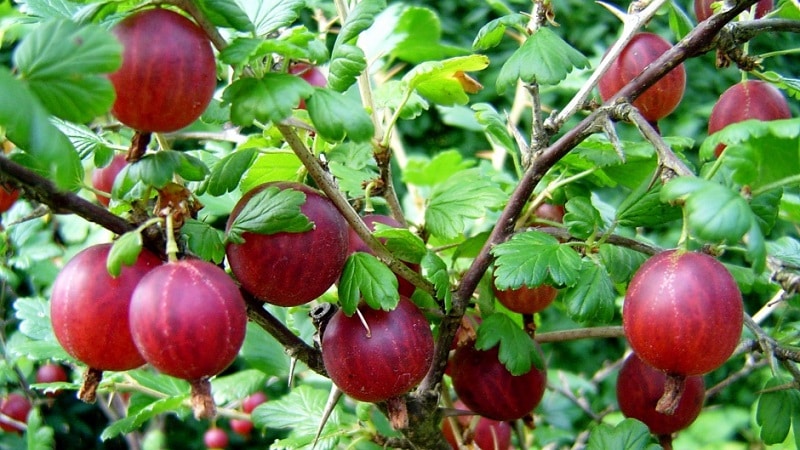The largest varieties of gooseberries
Large-fruited gooseberries - what's not a dream? Fragrant, juicy and crispy. The size and weight of the fruit depends on many factors: the characteristics of the variety, the amount of fertilizer applied, the planting location and weather conditions. Some bushes need to be tied to a support, otherwise the shoots will break under the weight of heavy fruits. The use of large berries is universal - they are suitable for processing, storage, fresh consumption, and transportation. Let's consider the largest gooseberry varieties, their characteristics and cultivation features, as well as reviews from experienced gardeners.
The largest green varieties
Green gooseberry rich in vitamins, used not only in cooking, but also in folk medicine and cosmetology. Gardeners distinguish two large-fruited green varieties - Donetsk and Ural grapes.
Donetsk
Self-pollinating variety of Ukrainian selection is easy to grow. The branches are upright and spreading. The height of the bush is about 90 cm, the shoots along the entire length are covered with thorns. With proper care and maintaining moisture levels, the weight of the berries reaches 10 g, some specimens grow up to 13 g. The color is light green, the shape is oval-round. Medium density peel with waxy fluff. The ripening period of Donetsk is mid-early - harvested in the second ten days of July. The taste is sweet and sour, harmonious. Fresh fruits can be stored for up to 4 days. Donetsk gooseberries are used fresh, processed, and added to baked goods.

What does Donetsk say about large-fruited gooseberries? Maria from Moscow region: “I’ve been growing Donetsk for a long time, I like its taste and size. I make jam and jams from berries, my whole family loves them. Gooseberries do not require much time to grow. Among the disadvantages, I would mention the sharp thorns - you can get hurt. Otherwise, Donetsk suits me, I recommend it for landing.”.
Attention! To get a rich gooseberry harvest, it is recommended to regularly carry out preventive measures. Three times a season, the bushes are fed with potassium-phosphorus fertilizers and sprayed with a solution of copper sulfate. Fertilizing increases disease resistance and strengthens gooseberry immunity.
Ural grapes
Early ripening dessert variety. The bushes are vigorous, the shoots are spreading. The branches grow straight up or at an angle, strewn with small thorns. The leaves are glossy, rich green. The berries are oval, weighing from 2 to 10 g, depending on the place of cultivation and the age of the bush. The skin is thin, emerald green. The pulp is tender and aromatic, the taste is sweet and sour, refreshing. The yield of the variety is from 3.5 to 7 kg per plant per season. Immunity to fungal and viral diseases is average, shedding is strong. Gooseberries are used to make jams and pastilles or eat the berries fresh.

Olga Gennadievna, Kurgan: "Variety Ural grapes frost-resistant, the buds do not freeze even in the coldest winters. Fruiting is extended, I pick berries 2-3 times per season. One bush produces up to 4 kg of fruit. Ural grapes rarely get sick. However, if you don’t pick ripe berries for a long time, they fall off.”.
It can be useful:
Pink large gooseberry
The large-fruited Ural Pink variety is in demand throughout the country. He frost-resistant, takes root in cold regions. The bushes are weak-growing and slightly spreading, the thorns are located along the entire length of the shoot, short and non-thorny. The berries are oval, pink, weight varies from 4 to 8 g. The taste of the fruit is soft and sweet, the aroma is average. The pulp is tender, juicy, with small seeds. Tasting rating of Ural Rose is 5 points. It is rarely affected by diseases and pests.

Raisa, Chelyabinsk: “A neighbor recommended Ural pink gooseberries to me. The bushes grow small and neat, I tie them to a trellis so that the branches do not sag. The berries are beautiful, pinkish-red, the pulp is very tasty, sweet, refreshing. I make jams from gooseberries and eat the fruits straight from the garden.”.
Yellow large-fruited variety
Of the yellow varieties, summer residents distinguish gooseberries Russian yellow. Medium ripening period, harvested in July. The variety is early-bearing and bears fruit in the third year after planting. Russian yellow is unpretentious in cultivation; seedlings quickly adapt to external conditions and take root in the soil.

The bushes are medium-sized and slightly spreading, the thorniness is average. The leaves are light green, shiny. The berries are oval, weigh 5-7 g, the skin is transparent, yellow, thin with a waxy coating. Russian yellow does not crack or fall off, the flesh is tender and tasty. Transportability is high. The berries are suitable for consumption in any form.
Evgeniy, Leningrad region: “Last year, Russian Yellow fell ill with powdery mildew, and we had to remove some of the adult shoots. I think the cause of the disease lies in high humidity. This year it bears fruit well, the berries are large, I collected 10 kg from two bushes. I like the taste of berries, soft and sweet".
Red gooseberry with large fruits
Red gooseberry differs not only in its original appearance, but also in its pleasant taste - the berries are soft and juicy, with a rich aroma. They shimmer beautifully in the sun, with golden veins visible.
Bogatyr
Medium-late variety, frost-resistant and drought-resistant. The bushes are compact, the crown is compressed, and the thorniness is small. The berries are oval or round, weigh from 10 to 17 g. The color is red or dark red, the flesh is tender with a dessert-sweet taste. Bogatyr is resistant to powdery mildew and rust, and is rarely damaged by bud mites, wasps and aphids. The yield of the variety is up to 8 kg per bush, the purpose of the berries is universal. Gooseberries are harvested in August, fruiting lasts up to a month. Fresh berries are stored for up to 5 days; they are placed in a dry and dark room, for example, a ventilated basement or cellar.

Ivan Mikhailovich, Tyumen: “The Bogatyr variety is suitable for planting in the northern regions and areas of central Russia. Withstands temperatures down to -34°C, seedlings tolerate spring frosts. The berries grow tasty and beautiful, I grow them for sale.”.
Attention! Gooseberries do not tolerate waterlogging, so it is important to monitor the amount of moisture in the soil. Before each watering, the soil is loosened so that the water does not evaporate and lingers longer at the roots. Cold water is not used, it provokes the development of dangerous microbes. It is recommended to water the bushes with settled water at room temperature.
Leningradets
The ripening period of Leningradets is medium-late, harvested in late July or early August. The bushes are medium-sized, the shoots are of medium thickness, the thorniness is weak. The leaves are rich green, matte, slightly concave. The berries look attractive - dark red with a purple tint and pink veins.The thick skin protects the fruit from cracking. The taste is sweet and sour, tasting score - 4.3 points. Productivity is from 2 to 5 kg per plant, drought resistance is high. The variety is valued for its pleasant taste, commercial qualities, and stable fruiting.

Pavel Alekseevich, Moscow: “I rate Gooseberry Leningradets a four. The variety is good: large fruits, interesting color, juicy pulp. Fruiting occurs in the second ten days of July, the berries do not fall off. I use part of the harvest for canning, and sell part. For several years, the gooseberry was sick only once - there was not enough nitrogen.".
Grandee
 The early ripening variety Grand is widespread in all regions of Russia. The bushes are medium-sized, the shoots are fast-growing, there are small thorns. The leaves are dark green, matte, medium size. The berries are oval-round, weight - 7-8 g, the surface is even and smooth. The color is rich red, acquiring a brownish tint when fully ripe. The skin is thin and cannot be felt when consumed. The pulp is tender and sweet, the aroma is rich. Grand is ideal for fresh consumption and processing, resistant to fungal diseases, and not damaged by insects.
The early ripening variety Grand is widespread in all regions of Russia. The bushes are medium-sized, the shoots are fast-growing, there are small thorns. The leaves are dark green, matte, medium size. The berries are oval-round, weight - 7-8 g, the surface is even and smooth. The color is rich red, acquiring a brownish tint when fully ripe. The skin is thin and cannot be felt when consumed. The pulp is tender and sweet, the aroma is rich. Grand is ideal for fresh consumption and processing, resistant to fungal diseases, and not damaged by insects.
Polina, Krasnodar region: “Grand gooseberry is my favorite. It doesn't cause trouble and doesn't require much attention. I planted the bush 5 years ago, every year I collect 3-4 kg of large berries. The thorns do not scratch the skin, the berries come off easily. I eat them fresh with my children and make jam for the winter. After processing, the taste of gooseberries only gets better".
Interesting things on the site:
Gooseberries for the Moscow region, resistant to powdery mildew
Conclusion
Descriptions of gooseberry varieties Bogatyr, Donetsk, Grand, Russian Yellow will help you make the right choice.Some gardeners prefer red varieties, others prefer yellow or pink. For the Urals and Siberia, gardeners choose frost-resistant varieties, for the Moscow region and the south - drought-resistant ones. The most common are thornless gooseberries and varieties with immunity to diseases and pests. Large fruits are suitable for any type of processing - they are used to make compotes and jam, and add to desserts and baked goods.